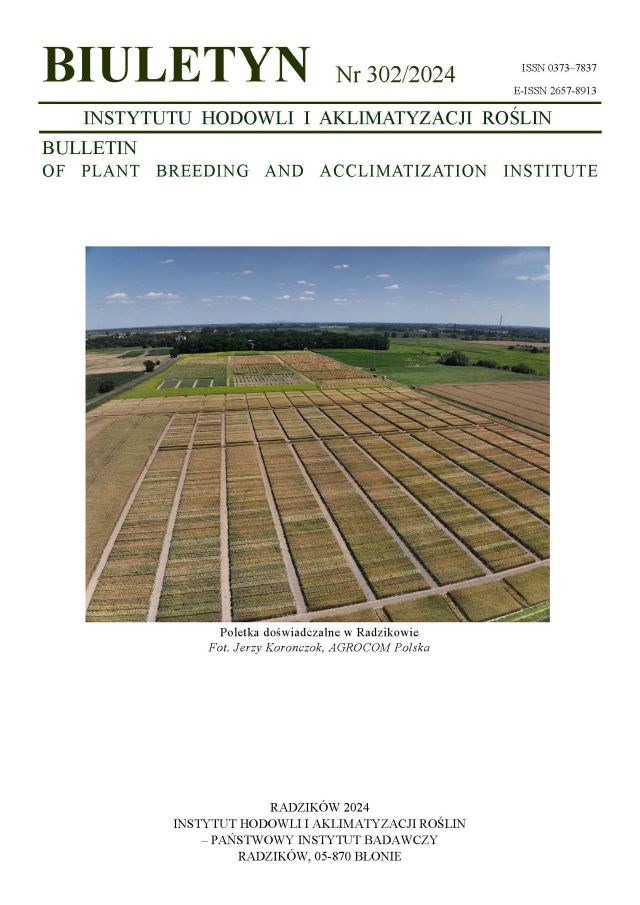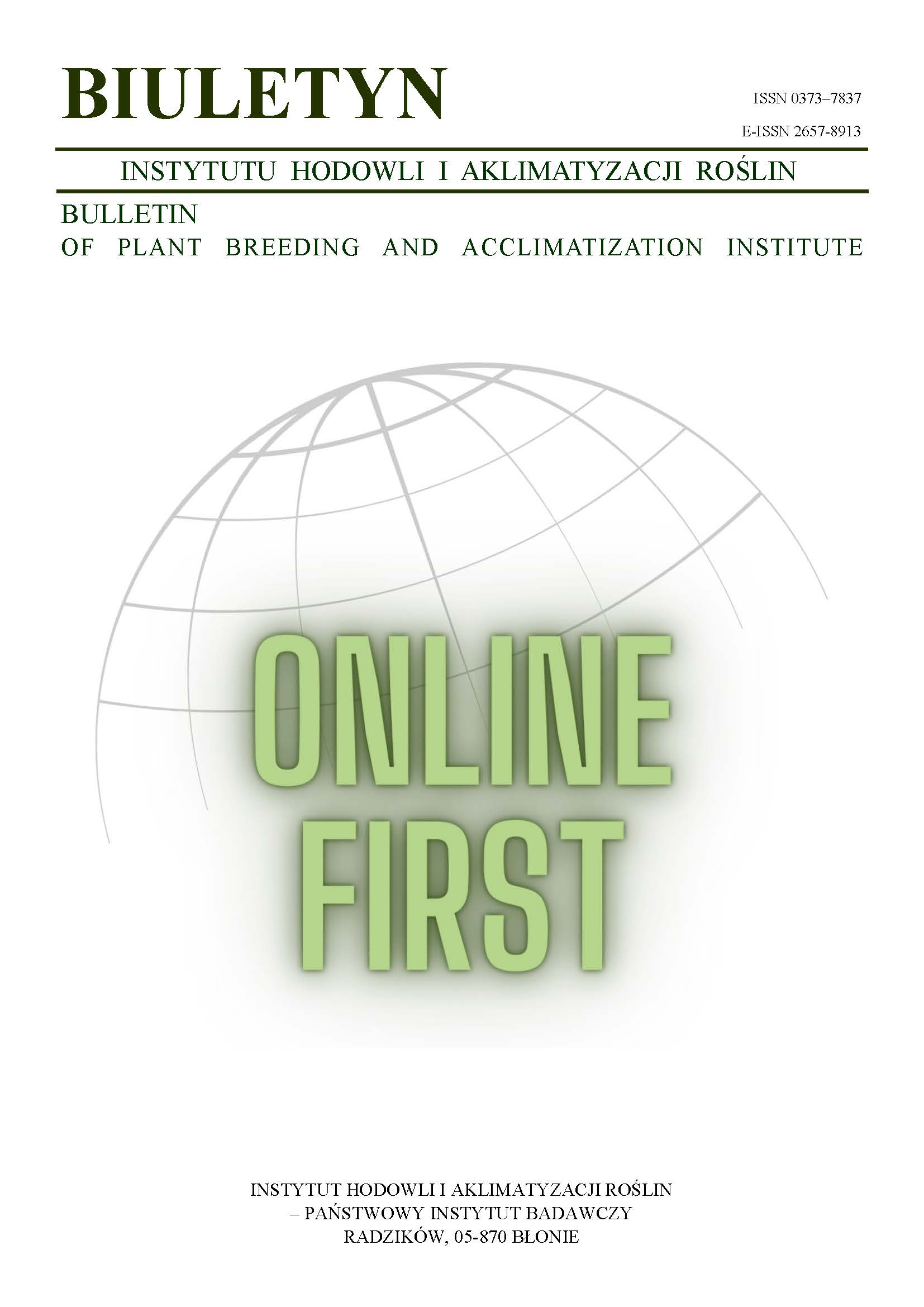The effect of a harvest effect and processing on seed sowing value of hulled and hull-less spring barleys
Krystyna Kolasińska
k.kolasinska@ihar.edu.plZakład Nasiennictwa i Nasionoznawstwa, Instytut Hodowli i Aklimatyzacji Roślin, Radzików (Poland)
Lech Boros
Zakład Nasiennictwa i Nasionoznawstwa, Instytut Hodowli i Aklimatyzacji Roślin, Radzików (Poland)
Abstract
The aim of the research was to determine the factors causing lower seed quality of hull-less barley cv. Rastik as compared with that of hulled barley cv. Rataj. Barley harvesting was done in seed production fields in 2002 using a plot combine and a regular combine. The seeds harvested with plot and regular combines were evaluated immediately after harvest, and then after processing. The seeds harvested with a regular combine were additionally evaluated after storage and final processing. The following parameters were estimated: moisture content, purity, proportion of damaged seeds and damage type, germination ability and seeds vigour. The hull-less barley grains were found damaged at the higher rate than those of the hulled barley. Even higher proportion of damaged grains was observed in seed lots sampled after final processing. The germinating power of seeds sampled immediately after harvesting with a plot combine and regular combine was 90.7% and 81.7%, respectively. Germination of seeds of cv. Rataj harvested with a plot combine was 89.5%, whereas that of seeds harvested with a regular combine was lower by 6%. Higher differences (up to 13%) were found in the case of hull-less cv. Rastik. The vigour of seeds harvested using a plot combine was greater than that of seeds harvested with a regular combine. The treatments during seed processing as well as storage conditions resulted in further decrease of sowing value of the hull-less barley cultivar.
Keywords:
hull-less barley, hulled barley, seed sowing valueReferences
Błaszkowski J., Piech M. 2002. Comparison of seed-borne fungal communities of naked and husked oats and barley, Phytopathologia Polonica 24: 73 — 76.
Google Scholar
Boros D., Cyran M., Rek-Ciepły B. 1998. A note on the nutritive value of hull-less barley. J. Anim. Feed Sci. 10: 497 — 504.
DOI: https://doi.org/10.22358/jafs/68002/2001
Google Scholar
COBORU 2002. Centralny Ośrodek Badania Odmian Roślin Uprawnych. Lista opisowa odmian. Rośliny rolnicze, zbożowe, okopowe, strączkowe, oleiste. Słupia Wielka.
Google Scholar
Dz.U. 2001. Dziennik Ustaw Rzeczypospolitej Polskiej 2001. Nr 108. Rozporządzenie Ministra Rolnictwa i Rozwoju Wsi z dnia 14 sierpnia 2001 r. poz. 1184.
Google Scholar
ISTA 1995. International Seed Testing Association. Handbook of Vigour Test Methods. 3rd Edition, 1995, ISTA PO Box 412, 8046 Zurich, Switzerland.
Google Scholar
ISTA 1999. International Seed Testing Association. International Rules For Seed Testing. Seed Sci. Technol. 27, Supplement, Rules: 335.
Google Scholar
ISTA. 2001. International Seed Testing Association. Rules Amendments. Seed Sci. Technol. 29, Supplement 2: 132.
Google Scholar
Grzesiuk St., Górecki R. J. 1994. Fizjologia plonów. Wprowadzenie do przechowalnictwa. Wyd. Akademii RT Olsztyn: 234 — 335.
Google Scholar
Grzesiuk St., Kulka K. 1981. Fizjologia i biochemia nasion. PWRiL, Warszawa: 480 — 505.
Google Scholar
Modarresi M., Rucker M. TeKrony D. M. 2002. Accelerating ageing test for comparing wheat seed vigour. Seed Sci. Technol. 30: 683 — 687.
Google Scholar
Opaku G., Gamble E. E. 1995. Seed quality of normal and naked OAC Kippen barley. Plant Varieties and Seeds. 8: 73 — 80.
Google Scholar
Strzelecki A.W. 1990. Uszkodzenia nasion i niedomłoty pszenżyta ozimego w zależności od odmiany i warunków zbioru kombajnem. Biul. IHAR 173 — 174: 211 — 218.
Google Scholar
White N. D. G., Hulasare R. B., Jayas D. S. 1999. The effect of storage conditions on quality loss of hulless and hulled oats and barley. Can J. Plant Sci. 79 (4): 475 — 482.
DOI: https://doi.org/10.4141/P98-115
Google Scholar
Wiewióra B. 2002. Plon i wartość siewna jęczmienia jarego w zależności od zastosowanej zaprawy nasiennej. VI Międzynarodowe Sympozjum. Genetyka Ilościowa Roślin Uprawnych. Duszniki Zdrój: 130 — 131.
Google Scholar
Authors
Krystyna Kolasińskak.kolasinska@ihar.edu.pl
Zakład Nasiennictwa i Nasionoznawstwa, Instytut Hodowli i Aklimatyzacji Roślin, Radzików Poland
Authors
Lech BorosZakład Nasiennictwa i Nasionoznawstwa, Instytut Hodowli i Aklimatyzacji Roślin, Radzików Poland
Statistics
Abstract views: 90PDF downloads: 25
License
Copyright (c) 2004 Krystyna Kolasińska, Lech Boros

This work is licensed under a Creative Commons Attribution-ShareAlike 4.0 International License.
Upon submitting the article, the Authors grant the Publisher a non-exclusive and free license to use the article for an indefinite period of time throughout the world in the following fields of use:
- Production and reproduction of copies of the article using a specific technique, including printing and digital technology.
- Placing on the market, lending or renting the original or copies of the article.
- Public performance, exhibition, display, reproduction, broadcasting and re-broadcasting, as well as making the article publicly available in such a way that everyone can access it at a place and time of their choice.
- Including the article in a collective work.
- Uploading an article in electronic form to electronic platforms or otherwise introducing an article in electronic form to the Internet or other network.
- Dissemination of the article in electronic form on the Internet or other network, in collective work as well as independently.
- Making the article available in an electronic version in such a way that everyone can access it at a place and time of their choice, in particular via the Internet.
Authors by sending a request for publication:
- They consent to the publication of the article in the journal,
- They agree to give the publication a DOI (Digital Object Identifier),
- They undertake to comply with the publishing house's code of ethics in accordance with the guidelines of the Committee on Publication Ethics (COPE), (http://ihar.edu.pl/biblioteka_i_wydawnictwa.php),
- They consent to the articles being made available in electronic form under the CC BY-SA 4.0 license, in open access,
- They agree to send article metadata to commercial and non-commercial journal indexing databases.
Most read articles by the same author(s)
- Lech Boros, Anna Wawer, Magdalena Wiśniewska, Danuta Boros, Effect of genotype and contrasting climate conditions on physical and chemical characteristics of soybean (Glycine max L. Merrill) , Bulletin of Plant Breeding and Acclimatization Institute: No. 296 (2021): Regular issue
- Wojciech Święcicki, Magdalena Gawłowska, Andrzej Górny, Dominika Ratajczak, Alicja Niewiadomska, Lech Boros, Identification of the regions in the pea genome, responsible for selected parameters of physiological efficiency, as an important element of resistance to the abiotic stresses , Bulletin of Plant Breeding and Acclimatization Institute: No. 286 (2019): Special issue
- Krystyna Kolasińska, The effects of natural methods of seed treatment on germination capacity and vigour of spring cereals produced in organic seed crop , Bulletin of Plant Breeding and Acclimatization Institute: No. 247 (2008): Regular issue
- Krystyna Kolasińska, Barbara Wiewióra, Relationships between seed sowing value and chemical content of maturing pea seeds (Pisum sativum L. ssp. sativum) , Bulletin of Plant Breeding and Acclimatization Institute: No. 226/227 (2003): Regular issue
- Krystyna Kolasińska, Elżbieta Małuszyńska, Seeds purity of spring cereals in organic seed production , Bulletin of Plant Breeding and Acclimatization Institute: No. 254 (2009): Regular issue
- Krystyna Kolasińska, Seed sowing value and reaction of spring cereals produced in organic seed crops to drought stress induced by polyethylene glycol , Bulletin of Plant Breeding and Acclimatization Institute: No. 251 (2009): Regular issue
- Lech Boros, Anna Wawer, Cultivar variation for field pea (Pisum sativum L.) seeds physico-chemical parameters and cooking time , Bulletin of Plant Breeding and Acclimatization Institute: No. 260/261 (2011): Regular issue
- Anna Wawer, Lech Boros, Principal component analysis of seed technological parameters of dry bean local population (Phaseolus vulgaris L.) from KCRZG IHAR – PIB , Bulletin of Plant Breeding and Acclimatization Institute: No. 283 (2018): Special issue
- Lech Boros, Combining ability of some agronomicaly important traits in pea (Pisum sativum L.) , Bulletin of Plant Breeding and Acclimatization Institute: No. 226/227 (2003): Regular issue
- Lech Boros, Evaluation of interrelations among some quantitative traits related to seed yield in pea (Pisum sativum L.) dry bean (Ph. vulgaris L.) and soybean (Glycine max L. Merrill.) , Bulletin of Plant Breeding and Acclimatization Institute: No. 226/227 (2003): Regular issue














